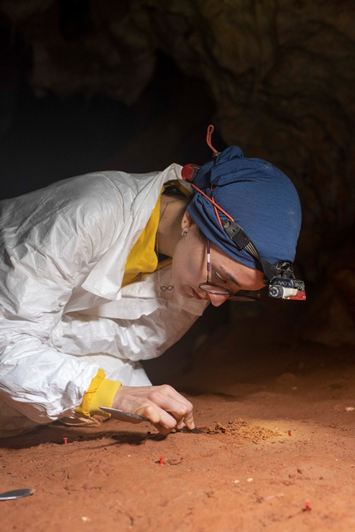 CÓRDOBA, SPAIN—A new study finds that people have frequently visited Spain’s Nerja Cave to view its paleolithic artwork over a period of tens of thousands of years, according to a statement from the University of Córdoba. The researchers analyzed charcoal and fossilized soot found on stalagmites in the cave, a technique developed by the study’s lead author, Marián Medina of the University of Bordeaux, that has been dubbed “smoke archaeology.” The results showed that people visited the cave over a 35,000-year-period, with the earliest visits dating to 41,000 years ago—10,000 years earlier than previously thought. For the period between 5000 and 1000 B.C., the researchers found that people visited the cave, which is located in the province of Málaga, on average approximately every 35 years. The study also revealed how people moved torches to illuminate the paintings found deep inside the cave. “The prehistoric paintings were viewed in the flickering light of the flames,” said Medina, “which could give the figures a certain sense of movement and warmth.” To read about the discovery in a different cave in Spain of the 18,700-year-old skeleton of a woman whose bones were coated with ocher, go to “The Red Lady of El Mirón.”
CÓRDOBA, SPAIN—A new study finds that people have frequently visited Spain’s Nerja Cave to view its paleolithic artwork over a period of tens of thousands of years, according to a statement from the University of Córdoba. The researchers analyzed charcoal and fossilized soot found on stalagmites in the cave, a technique developed by the study’s lead author, Marián Medina of the University of Bordeaux, that has been dubbed “smoke archaeology.” The results showed that people visited the cave over a 35,000-year-period, with the earliest visits dating to 41,000 years ago—10,000 years earlier than previously thought. For the period between 5000 and 1000 B.C., the researchers found that people visited the cave, which is located in the province of Málaga, on average approximately every 35 years. The study also revealed how people moved torches to illuminate the paintings found deep inside the cave. “The prehistoric paintings were viewed in the flickering light of the flames,” said Medina, “which could give the figures a certain sense of movement and warmth.” To read about the discovery in a different cave in Spain of the 18,700-year-old skeleton of a woman whose bones were coated with ocher, go to “The Red Lady of El Mirón.”
Spanish Cave Was a Popular Destination in Prehistory
